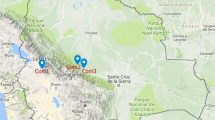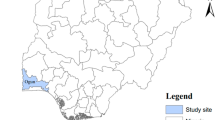Abstract
Limited scientific work is available on pesticide use and exposure in Suriname. Therefore, research was conducted to assess the application, safety practices (use of personal protective equipments (PPEs)), and potential risk of pesticide use by means of a face-to-face questionnaire and determination of the international estimated short-term intake (IESTI)). The amount of pesticide used was compared with the label and the in the European Union (EU) authorized dose. The majority of the farmers was male between 41 and 60 years and followed a primary education only. Less than 5 % of farmers used non-authorized pesticides. Results showed that most farmers (58 up to 100 %) apply a dose, which is within 0–100 % of the regulated dose (label and EU). Good results were obtained for the use of most PPEs. Statistical analysis did not reveal a significant difference between the different age classes, the different levels of education, and the use of PPEs. Pesticide residue analysis of four major crops showed that 22 % of the samples contained pesticides (13 % imidacloprid and 9 % chlorothalonil). The results for imidacloprid were higher than their respective maximum residue levels (MRLs) and were used for calculation of the IESTI. The highest observed IESTI value was 74.5 % of the EU acute reference dose (ARfD), giving rise to concern about pesticide usage. In Suriname, educational programs, good agricultural practices (GAP) training, sustainable agricultural practices, food monitoring studies, and legislative control mechanisms are urgently needed to protect farmer’s health and the environment and to ensure food safety.


Similar content being viewed by others
References
Abhilash, P. C., & Singh, N. (2009). Pesticide use and application: an Indian scenario. Journal of Hazardous Materials, 165, 1–12. doi:10.1016/j.jhazmat.2008.10.061. PMid: 19081675.
Burleigh, J. R., Vingnanakulasingham, V., Lalith, W. R. B., et al. (1998). Pattern of pesticide use and pesticide efficacy among chili growers in the dry zone of NE Sri Lanka (system B): perception vs. reality. Agriculture, Ecosystems & Environment, 70, 49–60.
Cataňo, H. C., Carranza, E., Huamani, C., & Hernández, A. F. (2008). Plasma cholinesterase levels and health symptoms in Peruvian farm workers exposed to organophosphate pesticides. Archives of Environmental Contamination and Toxicology, 55, 153–159.
"Census statistieken 2012". http://www.statistics-suriname.org/index.php/statistieken/downloads/category/3-bevolkingsstatistieken. Accessed 16 Jan 2015.
Cox, C. (2001). Insecticide factsheet, imidacloprid. Journal of Pesticide Reform, 20(1), 15–21.
Cropper, M. L. (1994). Economic and health consequences of pesticide use in developing country agriculture: discussion. American Journal of Agricultural Economic, 76, 605–607.
Daraghmeh, A., Shraim, A., Abulhaj, S., Sansour, R., & Ng, J. C. (2007). Imidacloprid residues in fruits, vegetables and water samples from Palestine. Environmental Geochemistry and Health, 29(1), 45–50.
De Putter, H and Van Sauers – Muller, A. (2008). Eindverslag Surituin deelproject: Terugdringen van redidu normen overschrijdingen in Surinaamse export groenten, 39 pages. https://www.wageningenur.nl/en/Publication-details.htm?publicationId=publication-way-333831383637.
Ecobichon, D. J. (2001). Pesticide use in developing countries. Toxicology, 160(1–3), 27–33.
EFSA (2013). EFSA assesses potential link between two neonicotinoids and developmental neurotoxicity. http://www.efsa.europa.eu/en/press/news/131217.htm. Accessed 7 February 2014.
Environmental statistics (2006). Suriname in cijfers no. 222-2006/04. Algemeen bureau voor de statistiek in samenwerking met CISur, mei 2006, 211 pages.
EU directive 2009/128/EC. http://eur-lex.europa.eu/LexUriServ/LexUriServ.do?uri=OJ:L:2009:309:0071:0086:EN:PDF. Accessed 2 June 2013.
Fernandez-Alba, A. R., Tejedor, A., Aguera, A., Contreras, M., & Garrido, J. (2000). Determination of imidacloprid and benzimidazole residues in fruits and vegetables by liquid chromatography-mass spectrometry after ethyl acetate multiresidue extraction. The journal of AOAC international 83, 748–755.
Fishel, F.M. (2012). Personal protective equipment for handling pesticides. UF/IFAS EDIS Document PI-28. http://edis.ifas.ufl.edu/pio61. Accessed 25 April 2014.
Galt, R. (2010). Scaling up political ecology: the case of non-authorized pesticides on fresh vegetables imported into the United States, 1996-2006. Annals of the Association of American Geographers, 100(2), 327–355.
Graafsma, T., Kerkhof, A., Gibson, D., Badloe, R., & van de Beek, L. M. (2006). High rates of suicide and attempted suicide using pesticides in Nickerie, Suriname, South America. Crisis, 27(2), 77–81. doi:10.1027/0227-5910.27.2.77.
http://gov.sr/media/614990/verboden_pesticiden.pdf. Accessed 25 June 2014.
Hurtig, A. K., San Sebastián, M., Soto, A., Shingre, A., Zambrano, D., & Guerrero, W. (2003). Pesticide use among farmers in the Amazon basin of Ecuador. Archives of Environmental Health, 58(4), 223–228. doi:10.3200/AEOH. 58.4.223-228.
Ibitayo, O. O. (2006). Egyptian farmers' attitudes and behaviors regarding agricultural pesticides: implications for pesticide risk communication. Risk Analysis, 26, 989–995. doi:10.1111/j.1539-6924.2006.00794.x.
Israel, Glen D., 1992. Determining sample size, Agricultural Education and Communication Department, University of Florida, IFAS Extension, PEOD6 (Reviewed 2013)
Issa, Y., Sham Abu, F., Nijem, K., Bjertness, E., & Kristensen, P. (2010). Pesticide use and opportunities of exposure among farmers and their families: cross-sectional studies: 1998-2006, from Hebron governorate, occupied Palestinian territory. Environmental Health, 9(63), 10.
Kneževič, Z., Serdar, M., & Ahel, M. (2012). Risk assessment of the intake of pesticides in Croatian diet. Food Control, 23(1), p.59–p.65.
Kumar, A., Verma, A., & Kumar, A. (2013). Accidental human poisoning with a neonicotinoid insecticide, imidacloprid: a rare case report from rural India with a brief review of literature. Egyptian Journal of Forensic Sciences, 3(4), 123–126.
LocalGAP Control Points and Compliance Criteria, All Farm Base/crop base/fruit and vegetables. Control points and compliance criteria intermediate level (2012). English version 4, edition 4.0-1_FEB2012. http://www.globalgap.org/export/sites/default/.content/.galleries/documents/140320_lg_il_cpcc_af_cb_fv_v1_0_en.pdf.
Lopus, S., Santibáñez, M., Beede, R., Duncan, R., Edstrom, J., Niederholzer, F., Trexler, C., & Brown, P. (2010). Survey examines the adoption of perceived best management practices for almond nutrition. California Agriculture, 64(3), 149–154. doi:10.3733/ca.v064n03p149.
Magauzi, R., Mabaera, B., Rusakaniko, S., Chimusuro, A., Ndlovu, N., Tshimanga, M., Shambira, G., Chadambuka, A., Gombe, N. (2011). Health effects of agrochemicals among farm workers in commercial farms of Kwekwe district, Zimbabwe. ISSN: 1937 – 8688.
Matthews, G. A. (2008). Attitudes and behaviors regarding use of crop protection products: a survey of more than 8500 smallholders in 26 countries. Crop Protection, 27, 834–846. doi:10.1016/j.cropro.2007.10.013.
Ministry of Agriculture in Suriname. Note regarding plant-, animal- and fisheries health In Suriname. http://www.minlvv.sr.org/smartcms/img/pdf/NOTE_REGARDING_PLANT,_ANIMAL_ANDFISHERIES_HEALTH_IN_SURINAME_VAN_DEBIE.pdf. Accessed 13 February 2013.
Ministry of Agriculture in Suriname, (2008). Annual report Ministry of Agriculture, Animal Husbandry and Fisheries. http://www.minlvv.sr.org/smartcms/downloads/Jaarverslag_LVV_2008.pdf. Accessed 15 March 2014.
National Profile Suriname, (2006). UNITAR Project National Profile Preparation, Priority Setting and Information Exchange for Sound Chemicals Management, MOA 2004G22 Toxicology Focal Point, Ministry of Public Health, May 2006.
Ngowi, A. V. F., Mbise, T. J., Millinga, L., Ijani, A. S. M., London, L., & Ajayi, O. C. (2007). Smallholder vegetable farmers in Northern. Tanzania: Pesticides use practices, perceptions, cost and health effects. Crop Protection. doi:10.1016/j.cropro. 2007.01.008.
Norkaew, S., Siriwong, W., Siripattanakul, S., & Robson, M. (2010). Knowledge, attitude, and practice (KAP) of using personal protective equipment (PPE) for chilli growing farmers in Huarua sub-district, Mueng district, Ubon Rachathani province, Thailand. Journal of Health Research, 24(2), 93–100.
NVWA, 2013. Nederlandse Voedsel en Waren Autoriteit. Personal communication Van der Schee, April 2013.
Panuwet, P., Siriwong, W., Prapamontol, T., Ryan, B. P., Fiedler, N., Robson, G. M., & Barr, B. D. (2012). Agricultural pesticide management in Thailand: status and population health risk. Environmental Science and Pollution, 17, 72–81.
Polidoro, B. A., Dahlquist, R. M., Castillo, L. E., Morra, M. J., Somarriba, E., & Bosque-Perez, N. A. (2008). Pesticide application practices, pest knowledge, and cost-benefits of plantain production in the Bribri-Cabécar Indigenous Territories, Costa Rica. Environmental Resources, 108, 98–106.
Quintero, A., Caselles, M. J., Ettiene, G., de Colmenares, N. G., Ramirez, T., & Medina, D. (2008). Monitoring of organophosphorus pesticide residues in vegetables of agricultural area in Venezuela. Bulletin of Environmental Contamination and Toxicology, 81(4), 393–396.
Recena, M. C., Caldas, E. D., Pires, D. X., & Pontes, E. R. (2006). Pesticides exposure in Culturama, Brazil knowledge, attitudes and practices. Environmental Resources, 102(2), 230–236. doi:10.1016/j.envres.2006.01.007.
Salameh, P. R., Baldi, I., Brochard, P., & Abi Saleh, B. (2004). Pesticides in Lebanon: a knowledge, attitude, and practice study. Environmental Resources, 94, 1–6. doi:10.1016/S0013-9351(03)00092-6.
Schreinemachers, P., & Tipraqsa, P. (2012). Agricultural pesticides and land use intensification in high, middle and low-income countries. Food Policy, 37(6), 616–626.
Snelder, D. J., Masipiqueña, M. D., & de Snoo, G. R. (2008). Risk assessment of pesticide usage by smallholder farmers in the Cagayan Valley (Philippines). Crop Protection, 27, 747–762.
Staatsbesluit no. 18, February 2005 (pesticide law Suriname, February 2005).
Van de Lande, H. (2001). Silent farmers: a preliminary study in the Commewijne district on the role of Surinamese women in agriculture highlighting the use of pesticides. Interactie: Journal of the Anton de Kom University of Suriname, 5, 55–60.
Van Sauers-Muller, A. and Ester, A., (2006). Een inventarisatie van het insecticide gebruik in de groenteteelt in Suriname in 2005. Surituin rapport, December 2006, 31 pages.
Van Spijker, B. A. J., Graafsma, T., Dullaart, H. I. A., & Kerkhof, A. J. F. M. (2009). Impulsive but fatal self-poisoning with pesticides among South Asians in Nickerie, Suriname: an exploratory autopsy study. Crisis: The Journal of Crisis Intervention and Suicide Prevention, 30(2), 102–105.
VWA project NW07840, 2008. Report of pesticide residue monitoring results of the Netherlands for 2008. Concerning directive 90/642/EEC, 86/362/EEC, Regulation 396/2005/EC and Recommendation 2008/103/EC.
WHO, 2008. Training package for the health sector. http://www.who.int/ceh/capacity/Pesticides.pdf. Accessed 18 June 2014.
WHO, 2010. The WHO recommended classification of pesticides by hazard and guidelines to classification 2009, ISBN 9789241547963, ISSN 1684-1042.
WHO, 2013. International estimated short-term intake (IESTI). http://www.who.int/foodsafety/chem/guidance_for_IESTI_calculation.pdf. Accessed, February 10, 2014.
Zhang, W. J., Bai, C. J., & Liu, G. D. (2007). A longer-term forecast on global supply and demand of food products. Journal of Food, Agriculture and Environment, 5(1), 105–110.
Zyoud, S. H., Sawalha, A. F., Sweileh, W. M., Awang, R., Al-Khalil, S. I., Al-Jabi, S. W., & Bsharat, N. M. (2010). Knowledge and practices of pesticide use among farm workers in the West Bank, Palestine: safety implications. Environmental Health Prevention Medicine, 15, 252–261.
Acknowledgments
This research was financed by the VLIR-AdeKUS-IUC, Project No. 4–5. The authors wish to thank Mr. P. Wongsowikromo and E. Troenosemito of the Ministry of Agriculture, Animal Husbandry and Fisheries Office in the Commewijne district. They would also like to thank the three university students, R. van Ampt, C. Vaseur, and S. Gopal for participating in this survey.
Author information
Authors and Affiliations
Corresponding author
Electronic Supplementary Material
Below is the link to the electronic supplementary material.
ESM 1
(DOCX 38.9 kb)
Rights and permissions
About this article
Cite this article
Mahabali, S., Spanoghe, P. Risk assessment of pesticide usage by farmers in Commewijne, Suriname, South America: a pilot study for the Alkmaar and Tamanredjo regions. Environ Monit Assess 187, 153 (2015). https://doi.org/10.1007/s10661-015-4363-3
Received:
Accepted:
Published:
DOI: https://doi.org/10.1007/s10661-015-4363-3




